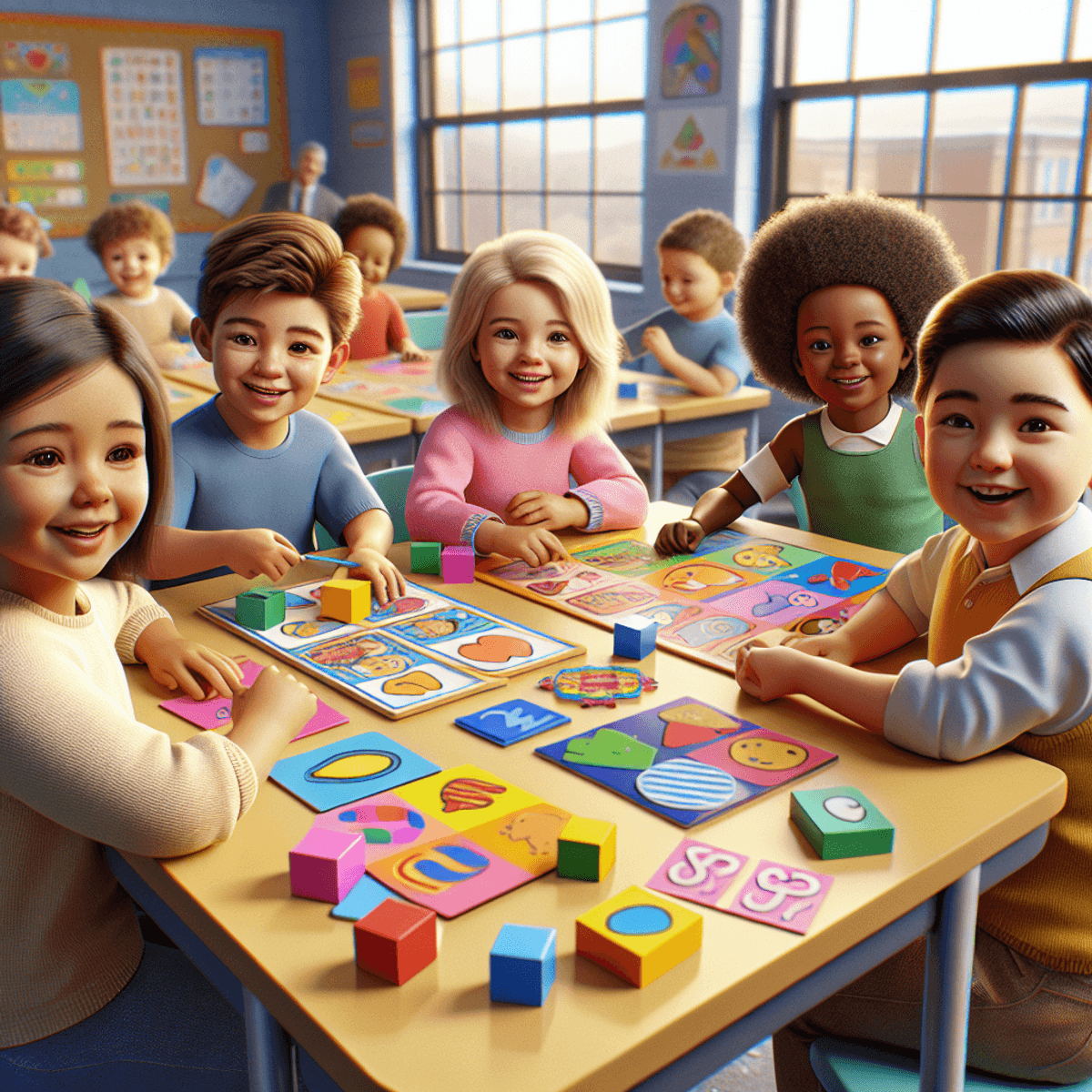
The Importance of Teaching Colors and Shapes in Early Childhood Education
Teaching colours and shapes to young children is essential for their cognitive development. These fundamental concepts serve as the building blocks for more complex learning. Introducing colours and shapes early on encourages:
- Recognition Skills: Identifying different colours and shapes aids memory and visual processing.
- Language Development: Describing colors and shapes enhances vocabulary and communication skills.
- Problem-Solving Abilities: Understanding relationships between objects fosters critical thinking.
Engaging children with various methods keeps them interested. Activities such as singing colours and shapes lyrics or using colours and shapes flashcards provide interactive experiences. Games, like the shapes and colours game, can make learning fun while reinforcing recognition skills.
Creative projects involving colours and shapes for babies, such as crafts or matching games, allow for hands-on exploration. This approach not only solidifies understanding but also promotes fine motor skill development.
Ultimately, teaching colours and shapes through enjoyable activities supports early cognitive growth, preparing children for future educational challenges. By incorporating playful methods, you can create a stimulating environment that nurtures curiosity and a love for learning.
Understanding Colors in Early Childhood Education
Colours are an essential aspect of our visual world. For young children, colour recognition plays a vital role in their cognitive development. Understanding colours is not merely about distinguishing between hues; it involves the ability to identify, name, and categorize them.
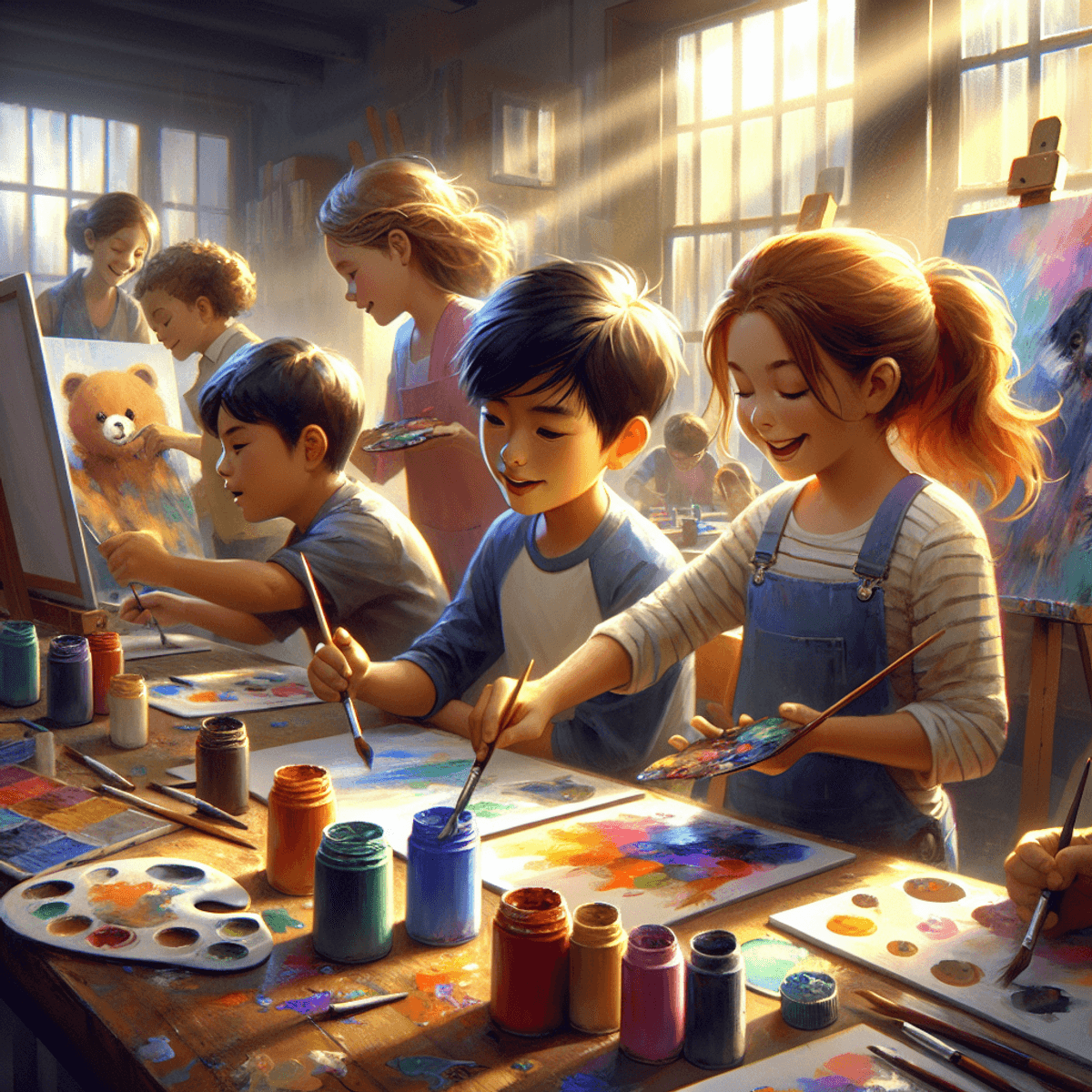
Childhood Education
Definition of Colors
Colours can be defined as different wavelengths of light perceived by our eyes. In early childhood, children begin to recognize colours as they interact with their environment. The perception of colour develops gradually, and children typically start identifying basic colours like red, blue, and yellow around 18 months of age.
Importance of Color Recognition
Colour recognition is crucial for various developmental milestones:
- Cognitive Skills: Recognizing colours helps toddlers enhance their cognitive abilities. It lays the foundation for more complex tasks like sorting and categorizing objects.
- Language Development: Naming colours introduces new vocabulary and aids in language acquisition. This process encourages communication as children express their observations.
- Social Interaction: Engaging in conversations about colours promotes social skills. Children learn to share their thoughts and preferences while interacting with peers or caregivers.
Common Methods to Teach Colors to Toddlers
Several effective strategies can help you teach colours to toddlers in enjoyable ways:
- Colourful Toys: Incorporating toys such as building blocks or stuffed animals in various colours can make learning fun. You can create games where children sort toys by colour or match them with corresponding objects around the house.
- Books: Picture books that emphasize colour concepts are excellent resources. Look for books featuring vibrant illustrations that highlight different colours. Reading these together not only fosters colour recognition but also encourages bonding time.
- Art Activities: Engaging toddlers in art projects using crayons, paints, or coloured paper allows them to explore colours creatively. Encourage them to experiment by mixing colours or creating their artwork using specific hues.
- Everyday Discussions: Integrating colour discussions into daily activities enhances learning opportunities. Pointing out colours during grocery shopping or nature walks helps solidify understanding through real-world context.
- Songs and Rhymes: Utilize simple songs or nursery rhymes focused on colours to reinforce learning through melody and rhythm. These auditory methods make it easier for children to recall information.
Incorporating these methods creates a rich environment for developing colour recognition-skills in young children. A playful approach ensures that learning remains engaging and impactful while fostering creativity and exploration at this foundational stage in their lives.
Age Appropriateness for Learning Colors
Introducing colours to young children typically occurs around 18 months. This age marks a significant phase in their cognitive development. During this period, toddlers begin to engage more with their environment and show curiosity about the world around them. Recognizing and naming colors becomes an exciting venture as they start to form connections between visual stimuli and language.
Key points regarding age appropriateness include:
- Developmental Milestones: At 18 months, many children can point to objects of specific colours when asked. They may also begin to use colour names in their vocabulary, indicating a grasp of basic colour concepts. This is often around the same time they start speaking in words, which further aids in their understanding of colours.
- Variability in Learning Pace: Each child is unique; while some may quickly understand colour distinctions, others might take longer. Factors influencing this learning pace can include:
- Individual Interests: Children who show a keen interest in art or nature might pick up colour recognition sooner than those who do not engage with colourful stimuli.
- Exposure and Interaction: Regular interaction with colourful toys, books, and activities enhances learning opportunities. Those with more exposure are likely to grasp concepts earlier.
Encouraging the exploration of colours through games and everyday interactions supports developmental milestones. Engaging toddlers in discussions about colours while playing or during daily routines strengthens their understanding.
Recognizing that each child learns at their own pace is crucial. Patience and consistent encouragement go a long way in fostering a love for learning colours. Creating a supportive environment where children can experiment with colors freely contributes positively to their cognitive growth, ensuring they feel comfortable exploring these fundamental concepts further.
Interactive Learning Tools for Colors
Engaging young children in colour recognition can be significantly enhanced through the use of educational apps and interactive games. These tools are designed specifically for toddlers, providing a fun and stimulating environment where they can learn while playing.
Popular Educational Apps
Here are some popular educational apps that can help toddlers learn about colours:
- Colour Monster: This app introduces colours through a friendly monster character that changes colours based on emotions. Children learn to associate different colours with feelings, making the experience both educational and relatable.
- Toddler Color Fun: Focused on interactive gameplay, this app includes various activities such as tapping, dragging, and matching colours. It keeps toddlers engaged while reinforcing their understanding of colours through vibrant visuals and playful sound effects.
Benefits of Interactive Games
Using interactive games offers several advantages for learning:
- Increased Engagement: The captivating visuals and sounds found in these apps hold children’s attention. When they are actively involved in the learning process, they tend to absorb information more effectively.
- Motivation to Learn: Game mechanics often include rewards such as stickers or points for correct answers. This gamification element encourages children to explore further, creating a positive association with learning colours.
- Skill Development: Many apps incorporate elements that promote fine motor skills, such as tracing or dragging coloured objects. These activities not only enhance colour recognition but also contribute to the overall development of hand-eye coordination.
Incorporating educational apps and interactive games into your child’s learning routine can be highly beneficial. These tools provide an innovative approach to teaching colours, fostering a love for learning through play while allowing you to track your child’s progress along the way.
Understanding Shapes in Early Childhood Education
Shapes are basic visual elements that are important for early cognitive development. They help children make sense of their surroundings by providing a way to organize and classify objects. Basic shapes like circles, squares, triangles, and rectangles are essential for understanding more complex concepts in mathematics and geometry.
Definition of Shapes
Shapes are the external form or outline of an object. In early childhood education, shape identification goes beyond just recognizing shapes; it also involves connecting shapes with real-world objects. For example, a circle can be associated with a wheel, while a square may remind children of a box. This connection reinforces their understanding of shapes as they relate to everyday life.
Role in Early Cognitive Development
Recognizing and understanding shapes is crucial for developing critical thinking and problem-solving skills. Shape identification improves spatial awareness, which is important for tasks like reading maps or navigating spaces. As children learn to differentiate between basic shapes, they enhance their observational skills and ability to compare and contrast different objects. The skills related to shape and space are foundational for future learning in various subjects.
Techniques for Teaching Shapes
There are several effective ways to teach shapes to young children:
- Shape Sorters: These interactive toys allow children to match specific shapes with corresponding slots. This hands-on activity helps develop fine motor skills while reinforcing shape recognition.
- Puzzles: Shape puzzles provide an engaging way for children to identify and fit pieces into designated spaces. This method encourages critical thinking as they figure out how different shapes interact with each other.
- Flashcards: Visual aids featuring various shapes can be used during playtime or structured learning sessions. Flashcards promote visual memory and help reinforce shape vocabulary.
- Art Activities: Incorporating shapes into art projects encourages creativity while teaching identification. Children can create collages using cut-out shapes or engage in painting activities where they focus on forming specific designs.
- Songs and Rhymes: Utilizing catchy songs that include shape names helps embed knowledge in a fun manner. Repetition through music aids retention and makes learning enjoyable.
Engaging children through these methods creates an environment where learning about shapes becomes a natural part of their daily experiences. The hands-on interaction with objects like shape sorters or the visual stimulation from puzzles promotes better understanding, ensuring that children are not just memorizing but truly grasping the concept of shapes.
Using a variety of teaching techniques increases children’s excitement about learning while building foundational skills needed for future academic success. Incorporating resources like the DRDP 2015 preschool guide can further enhance the learning experience by providing structured developmental assessment tools tailored for preschool education.

Learning Shapes
Age Appropriateness for Learning Shapes
Introducing shapes to children typically occurs around 2 years of age. At this stage, most toddlers begin to show interest in their environment and start to categorize objects based on different attributes, such as shape. Recognizing that children develop at varying paces is essential, as developmental readiness plays a significant role in learning.
Key Considerations for Teaching Shapes
- Individual Interests: Children may be more inclined to learn shapes if they are engaged with materials that capture their attention. For example, if a child shows a fascination with blocks, utilizing those blocks can create a natural opportunity for shape identification.
- Ability Variability: Some children grasp shape concepts sooner than others. While the general guideline suggests introducing shapes around 2 years, it’s important to observe each child’s unique development and readiness. This variability means some children might easily identify basic shapes like circles and squares by 18 months, while others may take longer.
- Learning Environment: Creating an interactive learning environment fosters exploration. Incorporating everyday items, such as toys or household objects that represent different shapes, can enhance recognition skills.
Practical Activities to Encourage Shape Learning
- Shape Sorters: These toys allow toddlers to match shapes with corresponding holes, promoting both recognition and fine motor skills.
- Puzzles: Shape-themed puzzles encourage problem-solving while reinforcing concept familiarity.
- Art Projects: Engaging in crafts that involve cutting out various shapes provides hands-on experience and solidifies understanding through creativity.
Recognizing when a child is ready to learn about shapes helps tailor educational experiences effectively. Paying attention to their interests and abilities will not only enhance learning but also nurture a love for discovery in early childhood education.
Interactive Learning Tools for Shapes
Using interactive learning tools in early childhood education can greatly improve children’s understanding of shapes. There are many games and apps specifically created to make learning about shapes fun and effective.
Popular Games and Apps
- Shape Builder: This app allows children to construct various shapes by dragging pieces into place, reinforcing both recognition and spatial awareness.
- Busy Shapes: An engaging game that encourages toddlers to match shapes with corresponding spaces, developing problem-solving skills while having fun.
Benefits of Engaging Visuals and Gameplay
Interactive tools offer several advantages:
- Visual Appeal: Colorful graphics capture children’s attention, making learning more enjoyable. Bright visuals help in associating shapes with real-world objects.
- Gameplay Elements: Incorporating play into learning sustains children’s interest and motivation. Games often include rewards or levels that encourage continued exploration.
- Skill Development: These tools promote fine motor skills through tapping, dragging, and manipulating shapes on screens.
Engagement through play fosters a deeper understanding of shapes. By using these educational resources, you can observe how children naturally gravitate towards hands-on activities that challenge them while providing positive reinforcement.
As young learners interact with these apps, they develop essential cognitive skills essential for future learning experiences. The combination of educational content with interactive gameplay creates a rich environment for mastering shape concepts effectively.
Combining Colors and Shapes in Learning Activities
Integrating colors and shapes into learning activities create a rich educational experience for toddlers. Using thematic lessons that combine these two fundamental concepts enhances understanding and retention. Engaging children in shapes and colours activities not only makes learning enjoyable but also promotes cognitive development.
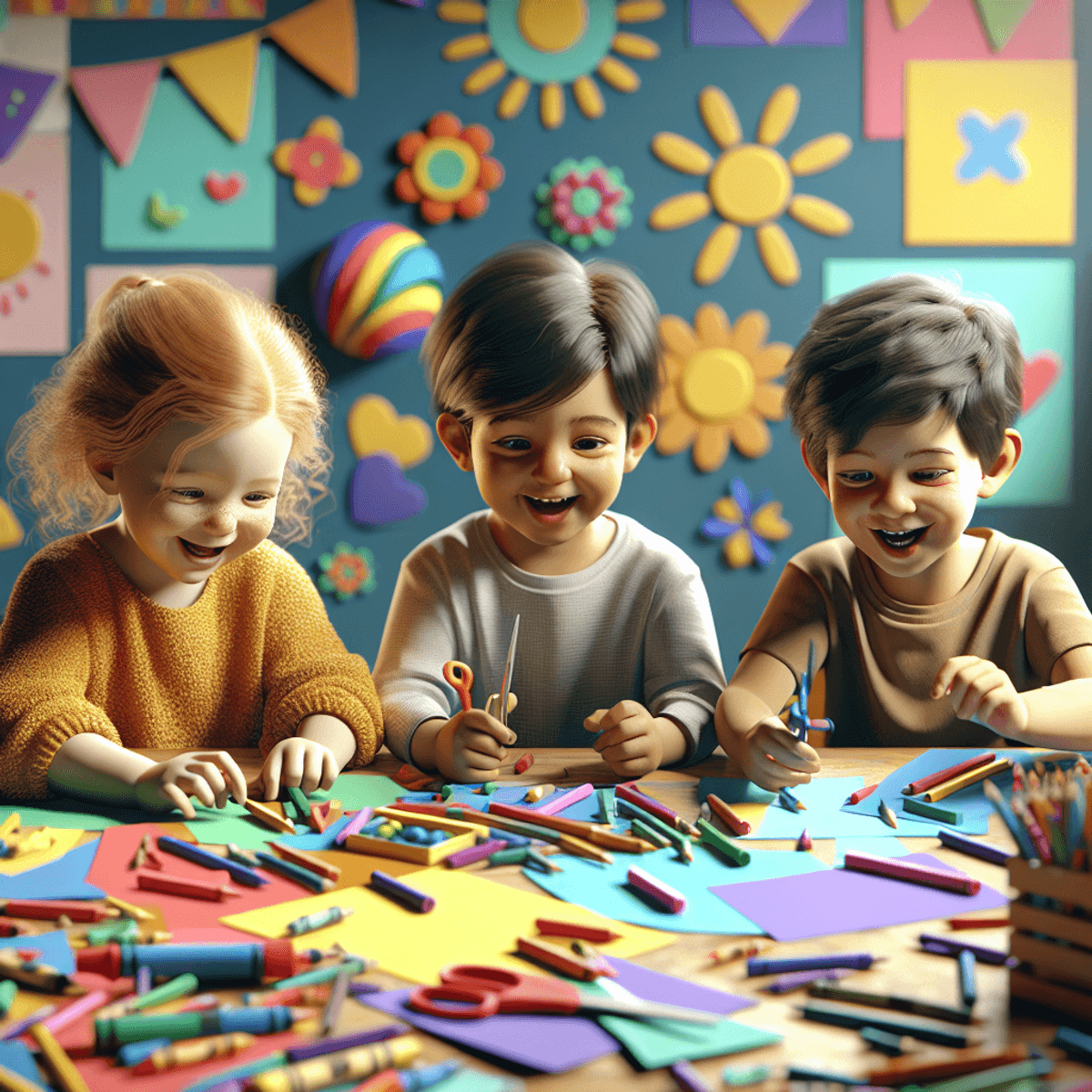
Learning Activities
Shapes and Colors Crafts for Toddlers
Craft projects provide an excellent way to teach both colours and shapes. Hands-on learning techniques engage young minds, allowing them to explore their creativity while solidifying their understanding of these concepts. Here are some creative craft ideas:
1. Rainbow Collage
- Gather cutouts of different shapes like circles, squares, triangles, and rectangles.
- Use colourful paper or magazines to create a vibrant rainbow collage.
- Encourage children to match the coloured shape cutouts with their corresponding sections on a larger rainbow template.
2. Shape Stamping
- Provide various shaped sponges dipped in different paints.
- Let toddlers stamp shapes onto paper, creating an abstract masterpiece filled with patterns and colours.
- This activity reinforces shape recognition while introducing colour blending as they overlap stamps.
3. Colorful Shape Mobile
- Use cardstock to cut out various shapes in multiple colours.
- Help children string these shapes together using yarn to create a colourful mobile.
- Hang it in their room as a constant visual reminder of what they have learned.
These projects offer benefits that extend beyond just recognizing colours and shapes:
- Increased Motivation: Engaging activities keep toddlers excited about learning. The playful nature of crafts reduces anxiety associated with new concepts, encouraging them to participate actively.
- Fine Motor Skill Development: Crafting requires hand-eye coordination which is essential for fine motor skills. Cutting, glueing, and arranging shapes help children practice these skills while having fun.
- Cognitive Connections: By associating colours with specific shapes during crafts, children make meaningful connections that enhance memory. These experiences also encourage them to articulate their thoughts about what they are creating.
Incorporating music into crafting sessions can elevate the experience further. Playing songs that emphasize colours and shapes while crafting allows for multi-sensory learning. Children can sing along as they create, reinforcing knowledge through rhythm and melody.
Integrated Learning Activities
Thematic lessons integrating both colours and shapes open up opportunities for diverse learning experiences:
1. Storytime Integration
Choose picture books focusing on themes of colours and shapes. Discuss the illustrations with children, pointing out various elements within the story.
Ask questions like “What colour is the circle?” or “How many triangles do you see?” This encourages critical thinking while reinforcing recognition skills.
2. Outdoor Exploration
Take children outside for a scavenger hunt where they search for items matching specific colors or shapes.
For example, ask them to find something round (like a ball) or something red (like a flower). This activity connects their environment to their learning.
3. Interactive Games
Develop games where toddlers match coloured shape cards or sort objects by colour and shape.
This type of play promotes social interaction as they work together with peers or family members.
By providing varied experiences through arts and crafts alongside integrated learning activities, you cater to different learning styles. Visual learners benefit from colourful displays, auditory learners thrive on songs and stories, while kinesthetic learners engage through hands-on activities.
Engagement remains key throughout these activities. Encouraging child-led exploration fosters independence while building confidence in their abilities to recognize colours and shapes.
The power of combining arts and crafts within early childhood education cannot be understated. These methods not only create memorable experiences but also lay a strong foundation for complex concepts in later education stages. Children who grasp these basic skills early often exhibit enhanced problem-solving abilities as they progress academically.
Shapes and Colors Games
Engaging children in shapes and colour activities through play provides a dynamic way to reinforce their understanding of these fundamental concepts. Various games designed for young learners can effectively integrate both shapes and colors, making learning fun and interactive.
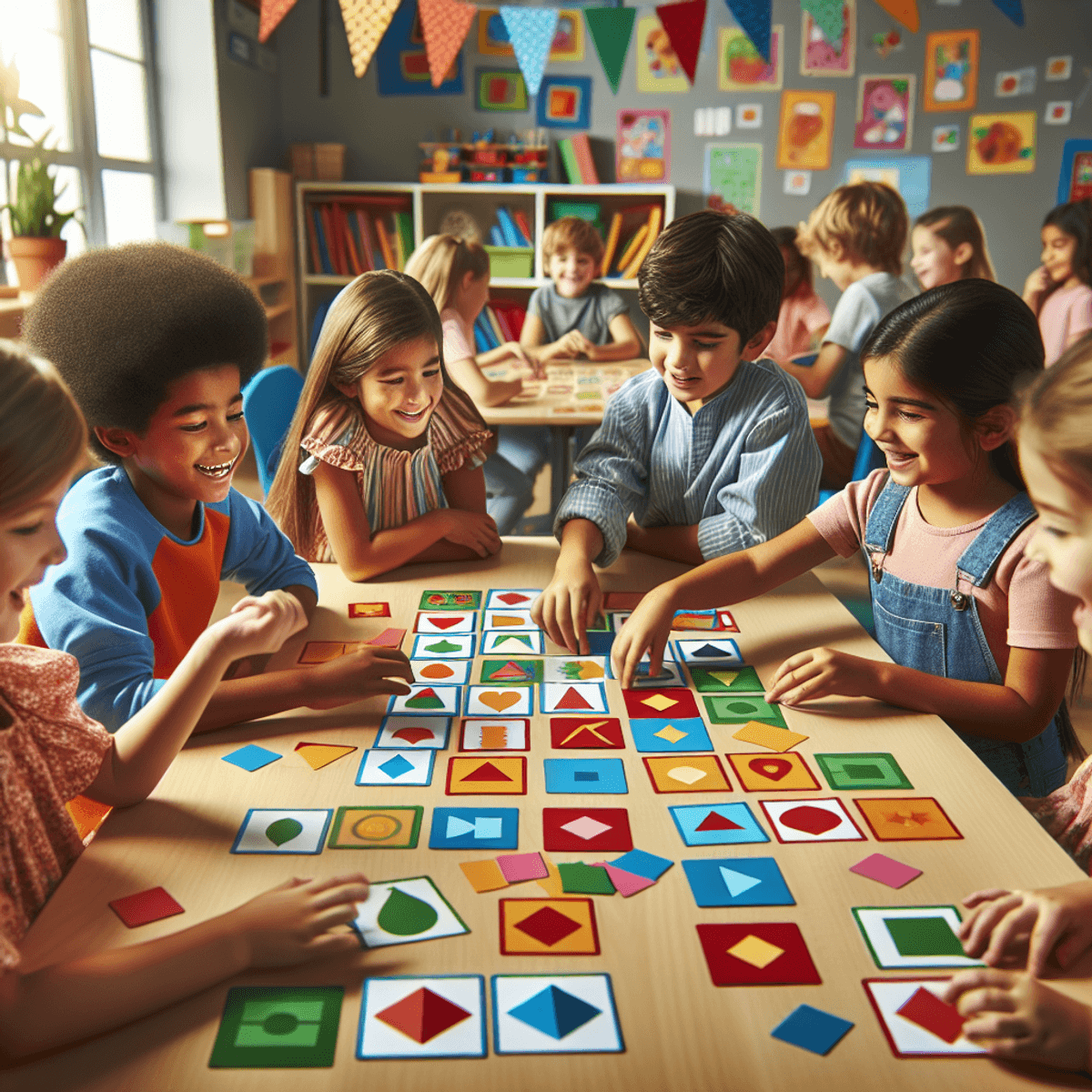
Shapes and Colors Games
1. Matching Games
These games require children to find pairs of objects that match in either shape or color. For example, using colored cards with different shapes, kids can sort them into groups. This activity promotes visual discrimination while enhancing their memory skills.
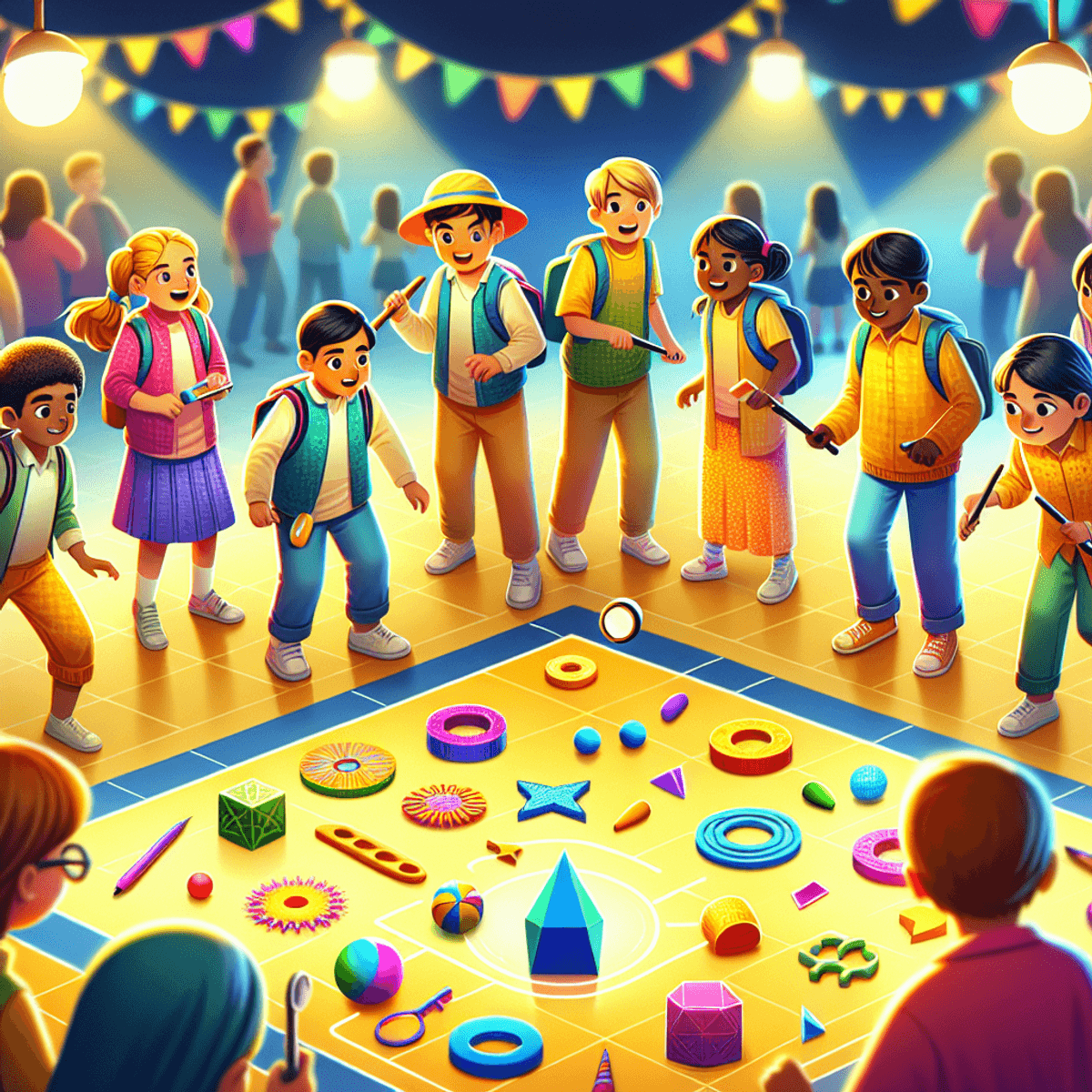
Matching Games
2. Scavenger Hunts
Create themed scavenger hunts where children search for objects matching specific colors or shapes around the home or classroom. For instance, you can ask them to find three red items or two circular objects. This encourages exploration and active participation, allowing toddlers to connect real-world experiences with abstract concepts.
3. Interactive Play Apps
Numerous educational apps focus on teaching shapes and colours through engaging gameplay. Look for options that offer tracing shapes or painting activities where children can select colours to fill in outlined shapes. These digital platforms foster hands-on learning while providing instant feedback, making the learning process enjoyable.
The significance of combining colours and shapes in educational activities cannot be understated. Engaging in these integrated learning activities promotes a holistic understanding of how these elements interact in everyday life. Children begin to recognize patterns, which is foundational for more advanced cognitive tasks later on.
Play serves as a critical component of cognitive development, particularly during early childhood. It fosters not only creativity but also problem-solving skills essential for navigating new challenges. Through playful interaction with shapes and colors for toddlers, kids develop their abilities to classify, compare, and manipulate these concepts.
Incorporating arts and crafts into playtime enhances the experience even further. For example, after a scavenger hunt, children could use the found items to create a colourful collage that reflects their discoveries. Such hands-on projects encourage deeper understanding and retention of knowledge while making learning a joyful adventure.
Engaging with fun learning games bridges the gap between education and play, ensuring that toddlers gain confidence in their abilities to identify shapes and colours while enjoying the process of discovery.
Educational Resources for Teaching Colors and Shapes
Teaching colours and shapes can be enhanced through various educational resources. These tools not only support children’s learning but also make the process enjoyable. Here are some effective resources:
Flashcards
- Visual Appeal: Flashcards are a popular tool for teaching colours and shapes due to their vibrant images and simple designs. They capture children’s attention and help them associate specific colours and shapes with visual representations.
- Versatility: Use flashcards during playtime or structured learning sessions, incorporate them into games where children match cards to objects in their environment, or create a fun memory game by flipping cards face down, allowing kids to find pairs.
Flashcards provide an excellent way for parents and educators to reinforce concepts straightforwardly.
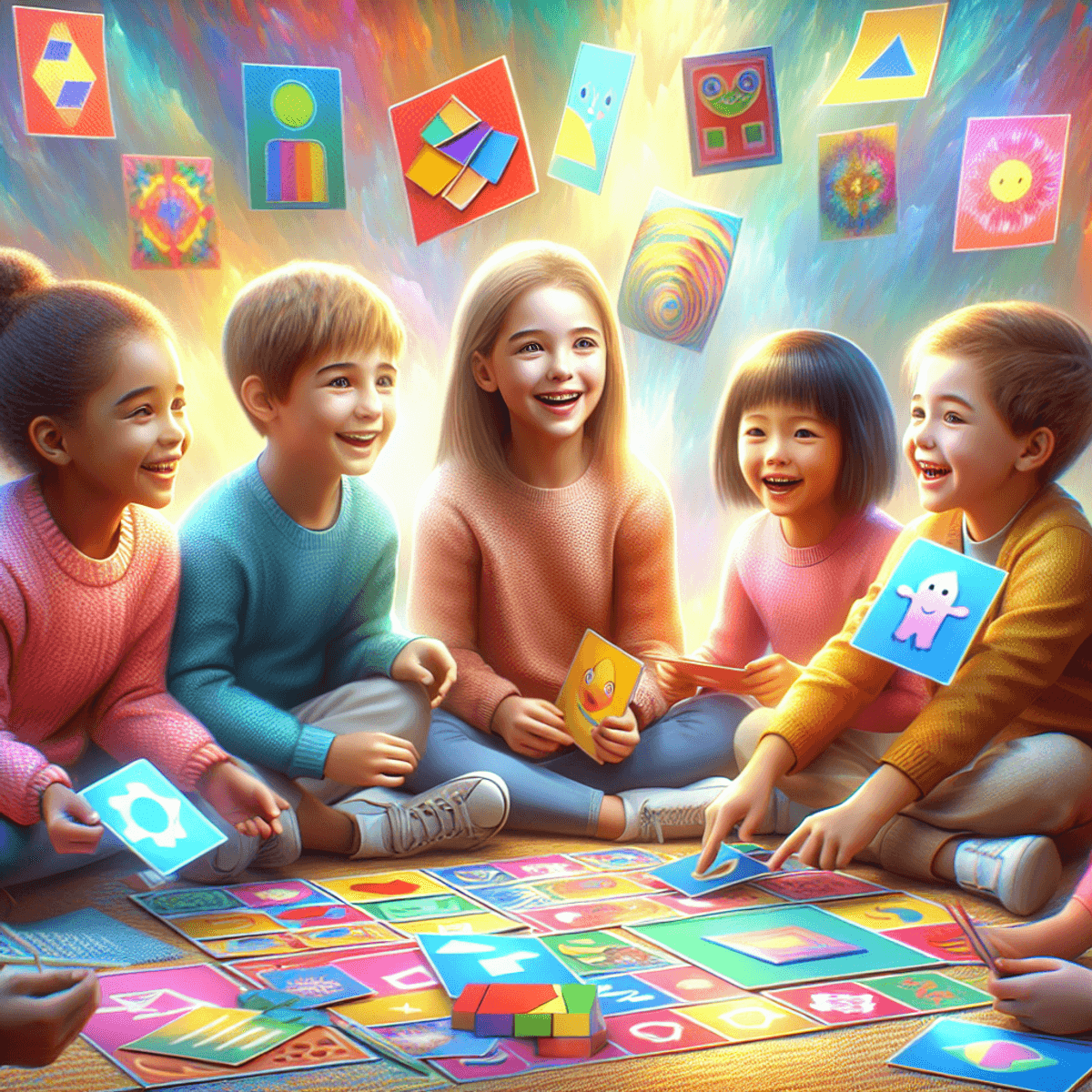
Colors and Shapes
Songs about Colors and Shapes
- Engaging Learning Tool: Songs can make learning both fun and memorable. The Shapes and Colors song is particularly effective as it combines catchy melodies with educational content. Children often remember lyrics better than spoken words, making songs an excellent method for reinforcing these fundamental concepts.
- Usage in Activities: Play the song during circle time or while engaging in crafts, and encourage children to sing along, which helps reinforce their understanding of colours and shapes through repetition.
Incorporating music into learning activities nurtures creativity while solidifying knowledge.
Utilizing VHS & Multimedia Resources
Historical Context of VHS
VHS tapes played a significant role in the evolution of educational resources. Programs like Shapes and Colors VHS provided interactive lessons that engaged children long before digital resources became prevalent. These vintage educational tools featured animated characters teaching concepts through storytelling, creating a foundation for early learners.
- Example from the Past: A classic VHS tape might show colourful characters exploring different environments, identifying shapes and colours in real-world contexts. This approach not only entertained but also educated, showcasing the effectiveness of multimedia learning.
Transition to Modern Digital Resources
The transition from traditional media like VHS tapes to modern digital platforms has expanded access to educational content significantly. Today, parents and educators can find numerous online resources that cater specifically to teaching colours and shapes.
- Availability of Online Videos: Websites such as YouTube offer countless videos designed for young learners, featuring interactive content that keeps children engaged.
- Interactive Websites: Numerous sites provide games and activities focused on recognizing colours and shapes. These platforms often include assessment features, making it easy for caregivers to track a child’s progress over time.
Educational apps available on mobile devices also enhance this learning experience, allowing children to engage with materials at their own pace while playing interactive games that promote colour recognition or shape identification.
Key Takeaways
Utilizing a combination of these educational resources can significantly enhance your child’s understanding of colours and shapes. The visual appeal of flashcards, the rhythmic nature of songs, and the nostalgia of VHS tapes, combined with the accessibility of modern multimedia tools create a rich learning environment. Engaging with these resources will stimulate your child’s cognitive development while providing enjoyable experiences that foster a love for learning.
FAQs (Frequently Asked Questions)
Why is teaching colours and shapes important in early childhood education?
Teaching colours and shapes is crucial for early cognitive development. It helps children understand their environment, enhances their observational skills, and lays the foundation for more complex learning tasks.
At what age should I start teaching my child about colours?
Typically, children can start learning about colours around 18 months. However, it’s important to recognize that each child learns at their own pace, and some may grasp colour concepts earlier or later.
What are some effective methods to teach colours to toddlers?
Common methods include using colourful toys, books, and interactive games. Engaging in activities like songs about colors or hands-on crafts can also enhance color recognition.
How can interactive tools aid in teaching shapes to young children?
Interactive tools such as educational apps and games provide engaging visuals and gameplay elements that make learning shapes fun. They increase motivation and help solidify shape recognition skills.
What types of crafts can help teach both colours and shapes?
Creative craft ideas like making a rainbow collage with differently shaped cutouts are excellent for integrating both concepts. These hands-on projects promote fine motor skill development while reinforcing colour and shape recognition.
Are there any multimedia resources that can assist in teaching colours and shapes?
Yes, flashcards, songs about colours and shapes, and even vintage VHS tapes can be effective educational tools. Modern digital resources like online videos or interactive websites have also become popular for teaching these concepts.
Read More About – An Insight into Each Family Member







Leave a Comment